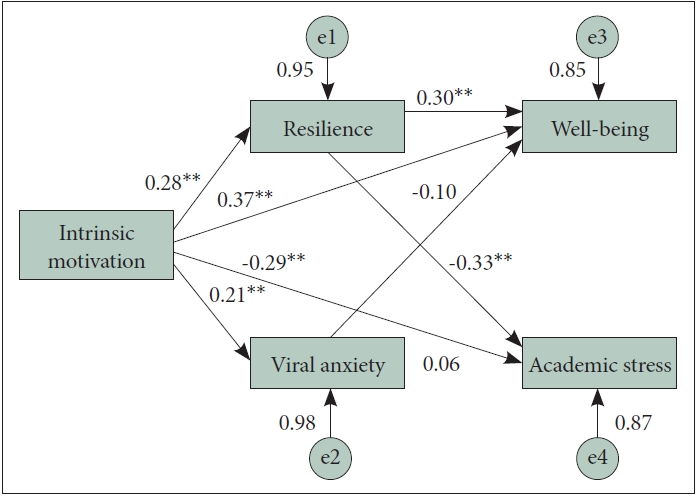2. Zhou T, Huang S, Cheng J, Xiao Y. The distance teaching practice of combined mode of massive open online course micro-video for interns in emergency department during the COVID-19 epidemic period. Telemed J E Health 2020;26:584-588.


5. Rosal MC, Ockene IS, Ockene JK, Barrett SV, Ma Y, Hebert JR. A longitudinal study of students’ depression at one medical school. Acad Med 1997;72:542-546.


6. Dahlin M, Joneborg N, Runeson B. Stress and depression among medical students: a cross-sectional study. Med Educ 2005;39:594-604.


7. Ahn D, Park G, Baek KJ, Chung SI. Academic motivation, academic stress, and perceptions of academic performance in medical students. Korean J Med Educ 2007;19:59-71.

8. Miller DG, Pierson L, Doernberg S. The role of medical students during the COVID-19 pandemic. Ann Intern Med 2020;173:145-146.


9. Marler EK, Bruce MJ, Abaoud A, Henrichsen C, Suksatan W, Homvisetvongsa S, et al. The impact of COVID-19 on university students’ academic motivation, social connection, and psychological well-being. Scholarsh Teach Learn Psychol 2021;Sep 30 [Epub]
https://doi.org/10.1037/stl0000294.

13. van der Merwe LJ, Botha A, Joubert G. Resilience and coping strategies of undergraduate medical students at the University of the Free State. S Afr J Psychiatr 2020;26:1471


26. Vitaliano PP, Maiuro RD, Mitchell E, Russo J. Perceived stress in medical school: resistors, persistors, adaptors and maladaptors. Soc Sci Med 1989;28:1321-1329.


27. Vallerand RJ, Pelletier LG, Blais MR, Brière NM, Senecal C, Vallieres EF. The Academic Motivation Scale: a measure of intrinsic, extrinsic, and amotivation in education. Educ Psychol Meas 1992;52:1003-1017.


28. Fairchild AJ, Horst SJ, Finney SJ, Barron KE. Evaluating existing and new validity evidence for the Academic Motivation Scale. Contemp Educ Psychol 2005;30:331-358.

31. Moon YS, Kim HJ, Kim DH. The relationship of the Korean version of the WHO Five Well-Being Index with depressive symptoms and quality of life in the community-dwelling elderly. Asian J Psychiatr 2014;9:26-30.


32. Duckworth AL, Peterson C, Matthews MD, Kelly DR. Grit: perseverance and passion for long-term goals. J Pers Soc Psychol 2007;92:1087-1101.


33. Lim HJ. An exploratory study on grit’s factor structure and its validity. Asian J Educ 2017;18:169-192.

34. Ríos-Risquez MI, García-Izquierdo M, Sabuco-Tebar EL, Carrillo-Garcia C, Martinez-Roche ME. An exploratory study of the relationship between resilience, academic burnout and psychological health in nursing students. Contemp Nurse 2016;52:430-439.


35. He FX, Turnbull B, Kirshbaum MN, Phillips B, Klainin-Yobas P. Assessing stress, protective factors and psychological well-being among undergraduate nursing students. Nurse Educ Today 2018;68:4-12.


36. Li ZS, Hasson F. Resilience, stress, and psychological well-being in nursing students: a systematic review. Nurse Educ Today 2020;90:104440


37. Souri H, Hasanirad T. Relationship between resilience, optimism and psychological well-being in students of medicine. Procedia Soc Behav Sci 2011;30:1541-1544.











